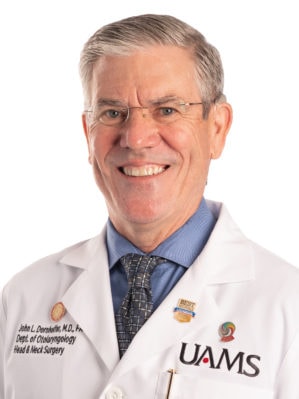By Amy Widner

John Dornhoffer, M.D., of the University of Arkansas for Medical Sciences (UAMS) is a cochlear implant surgeon who also understands what it is like to receive a cochlear implant. His insights are the topic of an article published today in JAMA Otolaryngology-Head & Neck Surgery.
Dornhoffer is chairman of the Department of Otolaryngology — Head and Neck Surgery in the UAMS College of Medicine. Like many of his patients, he has severe hearing loss. He received his cochlear implant in August 2015.
“This has been one of the most fascinating experiences I have ever had, both personally and professionally, and I feel that I have learned more from this one cochlear implant in my head than the 1,000-plus devices I have implanted in others,” Dornhoffer wrote in the piece, “An Otologist’s Experience as a Cochlear Implant Patient — The Power of Neuroplasticity.”
JAMA is a prestigious peer-reviewed medical journal published by the American Medical Association. Dornhoffer was invited by the JAMA editorial board to write the piece because of his rare opportunity to combine the perspective of both physician and patient.
Dornhoffer has performed more cochlear implant surgeries than anyone working in Arkansas and is world-renowned for his contributions to the surgical treatment of hearing loss. His deep understanding of the science behind implants allowed for some interesting — and surprising — discoveries as he observed his own hearing and brain change after surgery.
Cochlear implants are surgically implanted devices that replace lost hearing function in the ear. However, cochlear implants stimulate the cochlea with electrical impulses rather than auditory ones, so the brain has to learn how to interpret the new information and translate it into understandable sounds and speech. If the patient has some residual hearing, the brain has to reconcile the natural hearing ability with the information provided by the implant.
Not every brain relearns as quickly or as completely. Not every patient has the same success with cochlear implants.
For Dornhoffer, watching his brain adjust — in other words, observing its neuroplasticity — was one of the most amazing takeaways. Over time, tones he knew were being heard at the wrong frequency slowly slid into their correct place. Things that sounded abnormal corrected themselves. Music is always a little troublesome for cochlear implant patients, but even that improved once Dornhoffer realized his brain — and not his actual hearing ability — was filling in some of the missing details.
“I had no idea how important neuroplasticity of the brain was and how powerful it could be when learning how to hear with an implant,” Dornhoffer said.
His observations have resulted in changes to the advice he gives patients. For example, patients with hearing in the other, non-implanted ear were traditionally instructed to wear an ear plug while they adjusted to the implant. After his own experience, Dornhoffer now believes residual hearing actually helps the brain learn to work with the cochlear implant.
Dornhoffer concludes the piece by asking how physicians can better harness the neuroplasticity of the brain to improve the cochlear implant experience for more people.
“[Cochlear implants are] medicine’s first successful attempt to replace a special sense, and we have so much more to learn!” he said.
Dornhoffer has served on the UAMS faculty since 1994, as vice chairman of the department since 2009, and as chairman since 2017.
Dornhoffer has served in many clinical and academic leadership posts. He has directed audiology services since 1994 and the cochlear implant team since 2000. He has held the Samuel D. McGill Jr. Endowed Chair in Otolaryngology Research since 2002. He has authored or co-authored more than 120 articles and numerous book chapters. He lectures internationally and serves on several editorial review boards. He has served since 1999 as executive director of the Prosper Ménière Society, an international organization of physicians and scientists who specialize in the inner ear and Ménière’s disease, a condition that causes hearing loss and profound dizziness.
